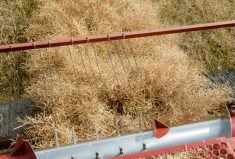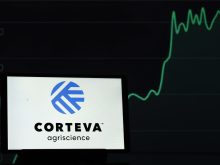CHICAGO, June 23 (Reuters) – Reports show average protein levels in the U.S. hard red winter (HRW) wheat crop are still the lowest in years, heightening concerns about quality as the harvest progresses in top producer Kansas.
Premiums for high quality HRW wheat with protein of 12 percent or more have swelled to levels unseen for nearly a decade, while prices for high protein spring wheat, which can be blended to boost quality, are at their loftiest in 2-1/2 years.
“It’s going to be a low-protein (HRW) crop; there is no real change in that. But are they finding some 12s? Sure,” said Dan Maltby, a broker with Risk Management Group.
Read Also

U.S. grains: Soybeans fall as rapid harvest overshadows China trade hopes
U.S. soybean futures closed lower on Friday as pressure from a fast-advancing U.S. harvest offset early-session support from hopes that upcoming U.S.-China talks could revive stalled soybean trade.
On the Kansas City cash market, premiums for HRW wheat with 12 percent protein stretched $1.28 a bushel above offers for 11 percent wheat last week, the widest spread between those grades since 2008.
Protein is one indication of wheat’s milling quality, and wheat with higher levels usually commands a higher price.
Prices for spring wheat, grown in the northern Plains, have soared on fears that drought will cut production. That has added to concerns about supplies of protein in the winter crop.
July spring wheat futures on the Minneapolis Grain Exchange (MGEX) reached $6.73 per bushel on Friday, the highest spot price in 2-1/2 years.
Plains Grains Inc, an industry group that conducts weekly tests of HRW wheat during harvest, said on Friday the average protein content of its first 133 samples was 11.1 percent, below last year’s unusually low average of 11.2 percent. Protein in the winter crop last year was the lowest since 1999 according to data from U.S. Wheat Associates, a trade group..
The tests last week gave a glimmer of hope, as they showed improvement from the previous week, when average protein levels were 10.8 percent.
Plains Grains attributed the week-on-week improvement to higher protein in wheat cut in northwest Texas and north central Oklahoma. The organization expects to test 530 wheat samples over the course of the harvest.
Wheat experts have attributed the low protein in this year’s HRW harvest to excessive moisture, coupled with low wheat prices that discouraged farmers from spending money on nitrogen fertilizer.
Plains Grains said the HRW harvest was 44 percent complete in Kansas.
In the northwest portion of the state, early harvest reports put protein in the 11 to 12 percent range, said Justin Gilpin, chief executive of the Kansas Wheat Commission.
But in the southern half of the state’s central corridor, protein levels were as low as nine percent, Gilpin said.














